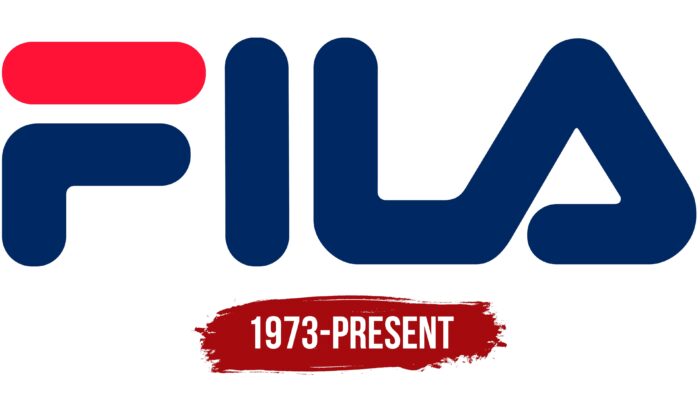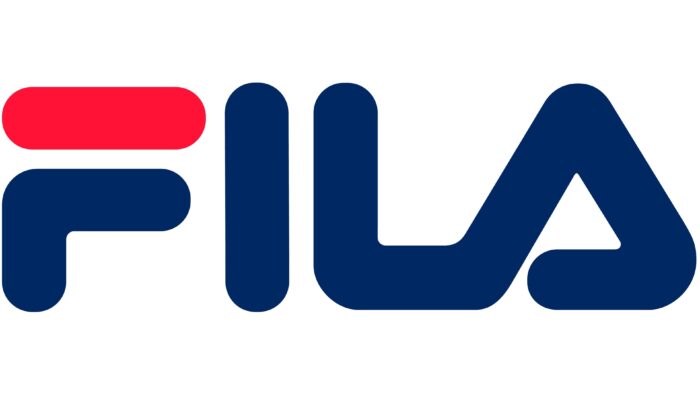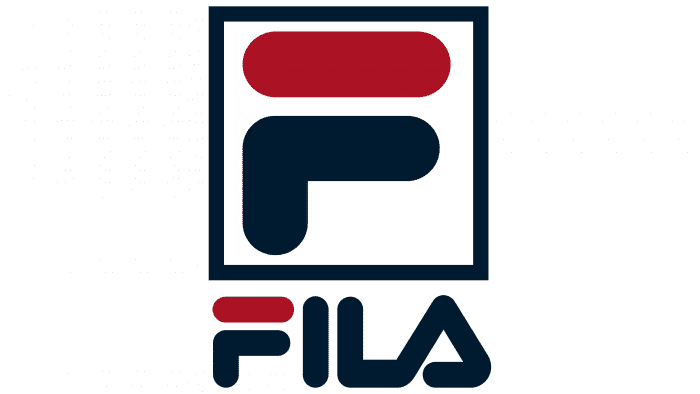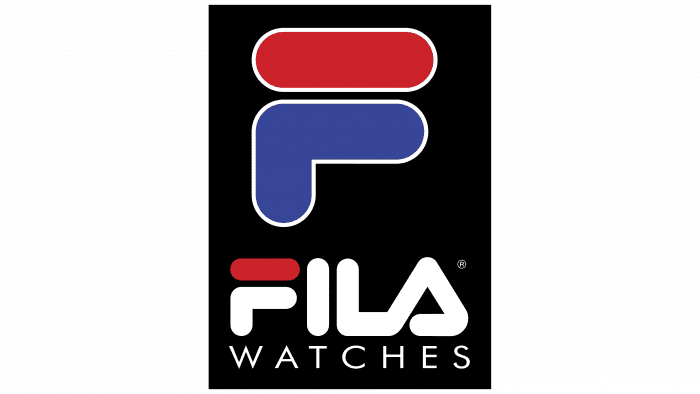The Fila logo draws consumer attention to its name, which carries a hidden meaning from Latin – “texture, style, nature.” The lettered sign symbolizes the dynamism and movement of the sports brand and emphasizes the uniqueness of its signature style.
Fila: Brand overview
| Founded: | 1911 |
| Founder: | Ettore Fila, Giansevero Fila |
| Headquarters: | Seoul, South Korea |
| Website: | fila.com |
Meaning and History
Fila was named after its founders – two brothers with the surname Fila. This word is now displayed in the logo, and its first letter, “F,” is associated with high quality and original design—initially, the manufacturer specialized in everyday knitwear. Sportswear appeared in its range almost a decade after entering the market.
Towards the 1970s, the brand focused on tennis equipment and accessories. The dress code of this sport implies wearing all white, so the Fila emblem was the only bright spot on a crystal clear background. Then basketball entered the company’s history. Michael Jordan, who was starting his career, wore items with its emblem. Soon after, other great players joined him. Now, sneakers and t-shirts with the iconic red and blue inscription can be seen not only on athletes: they have become part of the style of hip-hop fans and ordinary people who value comfort.
What is Fila?
Fila is a South Korean company with Italian roots. It appeared in the city of Biella in the Piedmont region at the dawn of the last century – in 1911. It was founded by the Fila family – Ettore and Giansevero. Today, the brand’s main direction is related to sports clothing and footwear. In 2003, it was acquired by the American company Sports Brand International, and four years later, it was sold to a buyer from South Korea.
1911 – 1973
The famous Italian brand grew from a modest family business producing underwear and knitwear, which opened in 1911. Its owners drew inspiration from the surrounding Alps, as the factory was located in the mountains. In 1923, the manufacturer made a step towards the big fashion market by partnering with Maglificio Biellese. This allowed it to go beyond its hometown and start filling the vacant niche of sports clothing. The Fila logo of that time has not survived, but it laid the foundation for the word mark that is familiar to all connoisseurs of unique styles today.
1973 – today
The Fila logo has had several versions. The first is known as the F-box, as it contains the letter “F” in a dark blue square. The rectangular frame is associated with a box, hence the original name. Even then, the letter “F” was composed of two parts. The upper part was a red horizontal line with rounded corners. Below was a short curved stripe, forming a right angle. It was blue, allowing designers to play with contrasts.
This emblem adorned the clothing of Swedish skier Jan Ingemar Stenmark, Italian mountaineer Reinhold Messner, and Swedish professional tennis player Bjorn Rune Borg. With them and many other athletes and celebrities, the company signed contracts as part of a large-scale marketing campaign.
The current logo was introduced in the late 1980s. The developers expanded the concept, removing the rectangle and adding other letters in a similar style. Thus, the now-famous brand name appeared with the inscription “FILA.” It is released in various color versions. Sometimes, a shortened emblem “F” without the square frame is used.
Fila: Interesting Facts
Fila is a famous brand known for its sports clothes and shoes, and its story goes back more than 100 years. It started in Italy in 1911 and first made fabrics.
- Italian Roots: Fila began in Italy by making quality fabrics. It wasn’t until the 1970s that they started focusing on sports clothes.
- Switching to Sports Clothes: Under new leadership, Fila made sporty, stylish clothes that worked well for athletes.
- Tennis Fashion: Fila made its mark with a tennis clothing line in 1973, worn by the tennis star Björn Borg. This line was all about looking good and playing comfortably.
- More Than Tennis: Fila didn’t stop at tennis; they got involved in basketball, golf, skiing, and running, sponsoring athletes in these areas, too.
- Famous Logo and Designs: Fila’s bold logo and innovative designs, like Velcro on tennis wear and a unique sneaker design, became well-known.
- Becoming International: Fila, originally Italian, was bought by Fila Korea in 2007, making it a big international brand.
- Back in Style: Fila recently became popular thanks to the ’90s fashion comeback and the trend of wearing sporty clothes as everyday fashion.
- Cool Partnerships: Fila worked with fashion designers and artists, mixing sports with modern fashion, which helped them reach new people.
- Caring for the Planet: Fila is trying to be more eco-friendly by using better materials and practices.
- Culture and Style: Fila isn’t just about sports; it’s also seen in movies and music videos and worn by famous people, making it a stylish choice beyond sports.
From starting as a small fabric maker in Italy to becoming a big name in sports and fashion worldwide, Fila has shown it’s all about changing while keeping things stylish and functional.
Font and Colors
The modern Fila logo is based on the classic F-box. It consists of straight and curved stripes. “I” looks like a vertical, rounded rectangle, with “L” and “A” merged into one whimsical form. And if the form of “L” can still be guessed, “A” looks more like an open triangle than a letter.
At first glance, the emblem seems abstract. It depicts the company name. Designers made the inscription unusual to emphasize the uniqueness of the brand style. Sharp lines express dynamism, as Fila is a sports brand where moving forward is always a priority.
The letters in the logo are not written but drawn, so the font can only be talked about conditionally. They were designed specifically for Fila. The word looks so original that it is difficult to read without knowing the brand name. Perception is more associative – abstract elements combine into a complete inscription, a set of straight and curved lines.
However, a similar font still exists: it appeared at the beginning of 2010. Inspired by the original style, typographer Julian Ilev invented the font Contemporary ONE. He took four letters from the company logo and developed the rest independently, guided by the proposed design.
The main colors of the Fila brand are red and blue. White is used as an additional color: it acts as a neutral background. Graphic artists have repeatedly experimented with shades. For example, the first logo has a dark blue color, and later versions have lighter tones.
The main palette remains unchanged, as it is associated with reliability and energy. In addition, there is a universal black-and-white version of the emblem, which looks appropriate in various visual contexts.
Fila color codes
| Dark Sapphire | Hex color: | #002864 |
|---|---|---|
| RGB: | 0 40 100 | |
| CMYK: | 100 60 0 61 | |
| Pantone: | PMS 2757 C |
| Tractor Red | Hex color: | #ff1134 |
|---|---|---|
| RGB: | 255 17 52 | |
| CMYK: | 0 93 80 0 | |
| Pantone: | PMS Bright Red C |
FAQ
What does the Fila logo mean?
The Fila logo signifies the brand name. At the same time, it symbolizes dynamism, conveyed in the form of unusual letters. This approach is incredibly beneficial for a company producing sports clothing and footwear, as movement is harmoniously transmitted in zigzags, bends, and rounded lines.
What font is the Fila logo in?
The Fila logo does not have a font; the letters in the company name are drawn and do not have conventional writing. The letter “F” consists of a horizontal line and a bend in the form of a right angle. The letter “I” is made as a bold vertical strip. “L” and “A” form a single structure reminiscent of a ski slope and a ramp for skateboarding. In 2010, designer Julian Ilev created the font Contemporary ONE based on these four letters.








